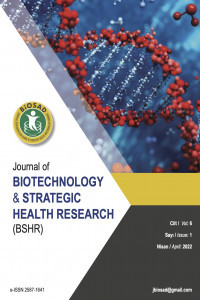Farklı Diş Macunlarının Antimikrobiyal Etkinliğinin İncelenmesi
agar difüzyon; antimikrobiyal; diş macunu
___
- 1. Cury JA, Tenuta LM. Evidence-based recommendation on toothpaste use. Braz Oral Res. 2014; 28: 1-7.
- 2. Bağış N. Farklı Diş Macunlarının Antibakteriyel Etkilerinin İn Vitro Olarak İncelenmesi. A.Ü. Dişhek Fak Derg. 2014; 41(2):77-88.
- 3. Brambilla E, Ionescu A, Cazzaniga G, Edefonti V, Gagliani M. The influence of antibacterial toothpastes on in vitro Streptococcus mutans biofilm formation: a continuous culture study. Am J Dent. 2014; 27(3): 160-166.
- 4. Degiam ZD. An In Vitro Antimicrobial Activity Of Six Commercial Toothpastes. Thi-Qar Medical J. 2010; 4(4): 127-33.
- 5. Motisuki C, Monti LL, Spolidorio DMP, Santos-Pinto L. Influence of sample type and collection method on Streptococcus mutans and Lactobacillus counts in the oral cavity. Arch Oral Biol. 2005; 50: 341-345.
- 6. Çakir FY, Gürgan S, Attar N. Çürük Mikrobiyolojisi. Hacettepe Diş Hek Fak Derg. 2010; 34(3): 78-91.
- 7. Lewis N, Parmar N, Hussain Z, Baker G, Green I, Howlett J, Kearns A, Cookson B, McDonald A, Wilson M, Ready D. Colonization of dentures by Staphylococcus aureus and MRSA in out-patient and in-patient populations. Eur J Clin Microbiol Infect Dis. 2015; 34:1823–1826.
- 8. Tazegül S, Koçak MM, Topuz Ö, Özcan S, Çekiç AA, Erten H. Üç Farklı Solüsyonun Streptococcus mutans ve Enterococcus faecalis Üzerine Antimikrobiyal Etkinliklerinin Değerlendirilmesi EÜ Dişhek Fak Derg. 2006; 27: 153-158.
- 9. Pinheiro ET, Gomes BP, Ferraz CC, Sousa EL, Teixeira FB, Souza-Filho FJ. Microorganisms from canals of root-filled teeth with periapical lesions. Int Endod J. 2003; 36: 1-11.
- 10. Krishnan PA. Fungal infections of the oral mucosa. Indian J Dent Res. 2012; 23: 650-659.
- 11. Moalic E, Gestalin A, Quinio D, Gest PE, Zerilli A, Le Flohic AM. The extent of oral fungal flora in 353 students and possible relationships with dental caries. Caries Res 2001;35:149-155.
- 12. De Rossi A, Ferreira DC, da Silva RA, de Queiroz AM, da Silva LA, Nelson-Filho P. Antimicrobial activity of toothpastes containing natural extracts, chlorhexidine or triclosan. Braz Dent J. 2014; 25(3): 186-190.
- 13. Lee SS, Zhang W, Li Y. The antimicrobial potential of 14 natural herbal dentifrices: results of an in vitro diffusion method study. J Am Dent Assoc. 2004; 135(8): 1133-1141.
- 14. Randall JP, Seow WK, Walsh LJ. Antibacterial activity of fluoride compounds and herbal toothpastes on Streptococcus mutans: an in vitro study. Aust Dent J. 2015; 60(3): 368-374.
- 15. Haraszthy VI, Zambon JJ, Sreenisavan PK. Evaluation of the antimicrobial activity of dentifrices on human oral bacteria. J Clin Dent. 2010; 21: 96–100.
- 16. Arnold WA, Dorow A, Langenhorst S, Ginter Z, Banoczy J. Effect of fluoride toothpastes on enamel demineralization. BMC Oral Health. 2006; 6: 1–6.
- 17. Witorsch RJ. Critical analysis of endocrine disruptive activity of triclosan and its relevance to human exposure through the use of personal care products. Crit Rev Toxicol. 2014; 44: 535–555.
- 18. Venegas SC, Palacios JM, Apella MC, Morando PJ, Blesa MA. Calcium modulates interactions between bacteria and hydroxyapatite. J Dent Res. 2006; 85: 1124-1128.
- 19. Enax J, Epple M. Synthetic Hydroxyapatite as a Biomimetic Oral Care Agent. Oral Health Prev Dent. 2018; 16(1): 7-19.
- 20. Guggenheim B, Lutz F, Schmid R. Caries and plaque itihibition in rats by five topically applied dentifrices. Eur J Oral Sci. 1997; l05: 258-263.
- Yayın Aralığı: Yılda 3 Sayı
- Başlangıç: 2017
- Yayıncı: Deneysel, Biyoteknolojik, Klinik ve Stratejik Sağlık Araştırmaları Derneği
Saadet PEKUSLU SANAR, Hülya DEMİRCİ
Hemofili A Tanısı Almış Bir Hastada Meydana Gelmiş Odontojenik Apsenin Tedavisi: Olgu Sunumu
Bilal Ege, Abdüssamed Geyik, Mustafa UTKUN
Diş Hekimliğinde Defansif Tıp Uygulamaları
Nesrin SARUHAN, Selma ALTINDİŞ, Gunay GOJAYEVA
İki Orta Gelirli Asya Ülkesinde (Malezya ve Bangladeş) Tıbbi ve Diş Sağlığı hizmetleri Sunumu
Muhd Firdaus CHE MUSA, Yang Rafidah HASSAN, Farina RAHMAN, Fatiha Tasmin JEENİA
Farklı Diş Macunlarının Antimikrobiyal Etkinliğinin İncelenmesi
Çiğdem ATALAYIN, Mustafa ATEŞ, Hüseyin TEZEL
Fitokimyasallardan Polifenollerin Periodontal Duruma Etkisi
Duygu DURMUŞ, Çiğdem COŞKUN TÜRER
Epstein-Barr Virus Proteinleri LMP1 ve EBNA1’in Antidiyabetik Tedavilere Potensiyel Katkısı
Serkan ŞEN, Merve ŞEN, Mustafa ALTINDİŞ, Sefa ÇELİK, Korhan ALTUNBAŞ, İbrahim Hakkı CİĞERCİ
Ahmet ALTINDİŞ, Alper CUMHUR, Elmas Pınar KAHRAMAN, Merve KÖSEOĞLU
Oral Mikrobiyota Araştırmaları Işığında Ağız Sağlığına Yeni Bakış Açısı: Derleme
